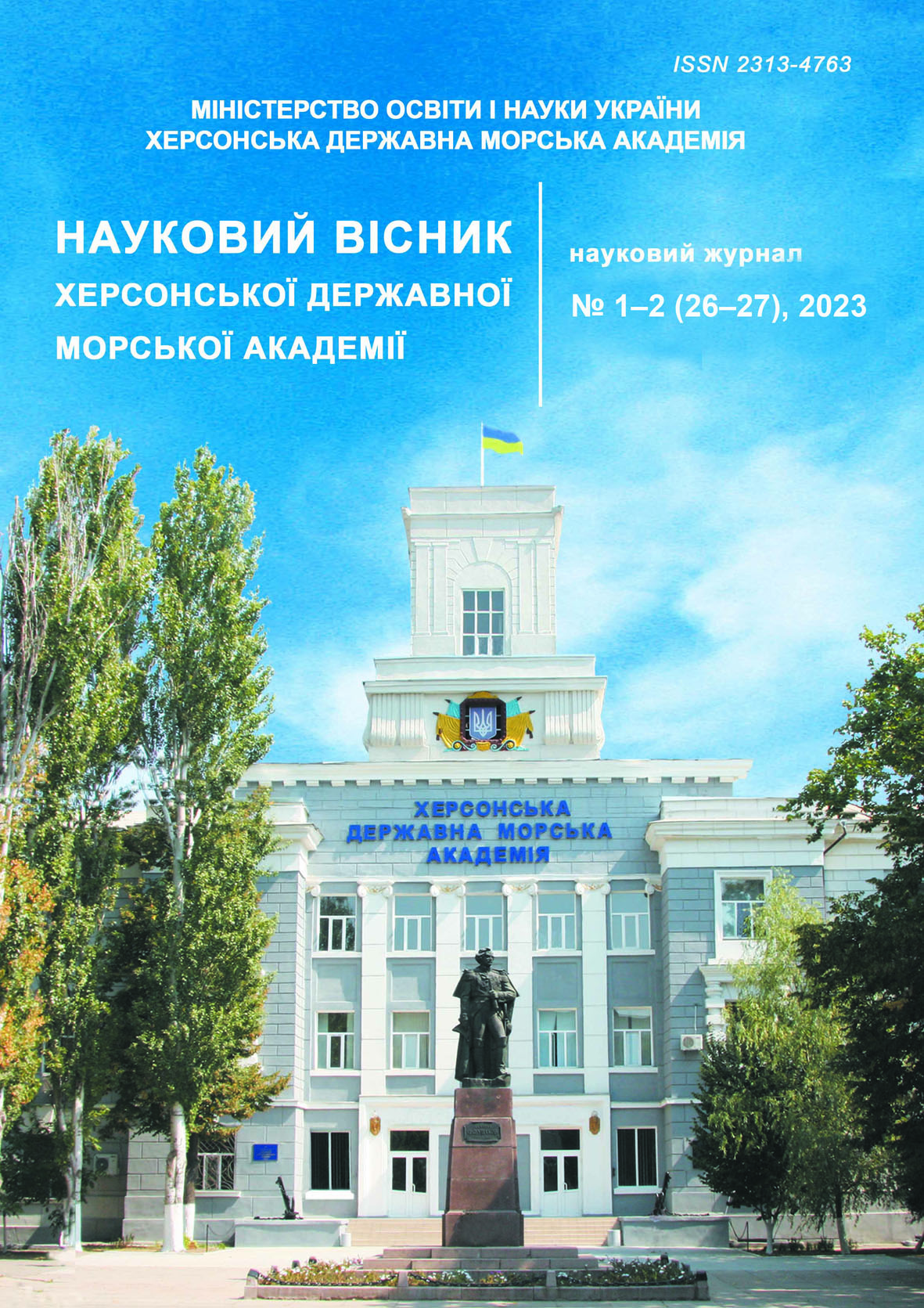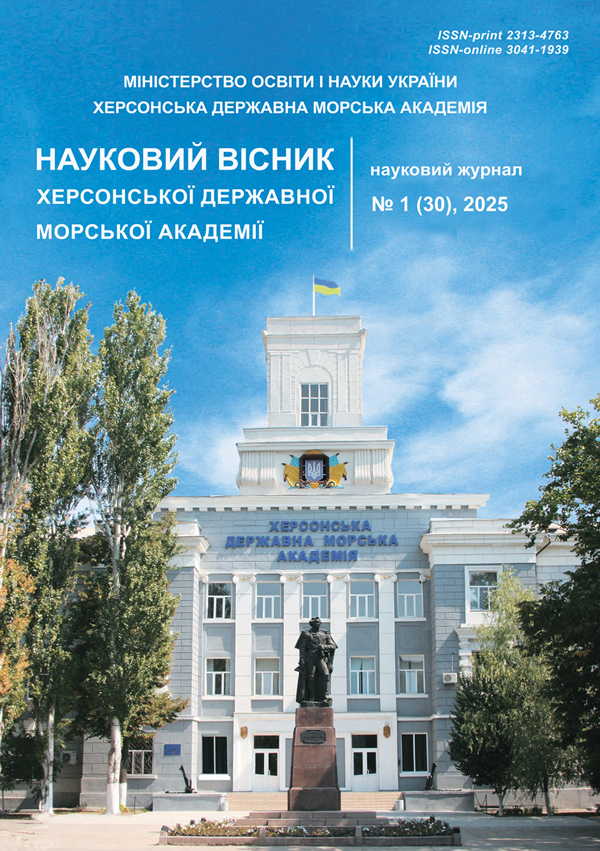LIMITS OF THE APPLICATION OF METHODS FOR DETERMINING THE CHANGE IN THE DRAFT OF A SEA VESSEL DUE TO A CHANGE IN THE DENSITY OF WATER
https://doi.org/10.33815/2313-4763.2025.1.30.046-058
Abstract
Abstract The article considers the problem of determining the change in the draft of a seagoing vessel due to a change in water density. Its practical significance is closely related to solving the problems of safe navigation. One such problem is the calculation of a vessel's draft at the stage of developing its cargo plan. Another is determining the cargo mass based on measuring the vessel's draft before and after cargo operations. A comparative analysis of several methods for determining the change in a ship's draft due to a change in water density has revealed the limits of their practical application. These limits are defined by the assumptions made when deriving the working formula. Failure to consider these limits can lead to gross errors in draft calculations and, in practice, to incorrect vessel loading. The methods under consideration are illustrated with specific examples.
The article also demonstrates the potential for expanding the practical significance of the marginal estimation method for determining draft changes not only in straight-walled vessels. The method is also useful in cases such as: estimating the upper limit of draft change caused by a change in water density; determining draft changes in cases where water density does not vary significantly during the ship’s passage.
A criterion is proposed that allows for evaluating the accuracy of the marginal estimation method for determining draft changes. In particular, it is shown that it is possible to identify critical values of the vertical fineness coefficient for a certain draft range at which the error of the marginal estimation method equals a specified value (for a given difference in water density). This criterion allows us to assess the conditions under which the discrepancy between the results of "exact" methods and the marginal estimation method may be acceptable for practical purposes.
Important areas of further research are related to improving the accuracy of measuring the ship’s draft and the water density, as the errors in these measurements significantly limit the accuracy of determining the vessel's displacement.
References
2. Mizhnarodna konventsiia pro vantazhnu marku. (1966). URL: https://zakon.rada.gov.ua/laws/show/896_007#Text.
3. Fossen, T. I. (2021). Handbook of marine craft hydrodynamics and motion control. Norwegian University of Science and Technology, Trondheim, Norway. Hoboken, NJ: Wiley.
4. Ivchenko, V. V. (2021). Fizyka dlia moriakiv u prykladakh i zadachakh. Mekhanika: navch. posibn.: u 2 ch. Ch. 1. Kherson: KhDMA.
5. Pursey, H. J. (1996). Merchant Ship Stability (Metric Edition). A Companion to ''Merchant Ship Construction''. Glasgow Brown: Son & Ferguson, LTD, Nautical publishers.
6. Clark, I. C., BSc, MSc. (2011). The Management of Merchant Ship Stability, Trim & Strength. London: The Nautical Institute.
7. Draught survey. Carefully to Carry Consolidated Edition 2023. Chapter 16. URL: https://is.gd/5vbOuv.
8. Ivče, R., Jurdana, I., Mohović, R. (2011). Determining weight of cargo onboard ship by means of optical fibre technology draft reading. Promet-Traffic and Transportation. Vol. 23 (6). 421–429. https://doi.org/10.7307/ptt.v23i6.177.
9. Wei, Y., Du, H., Hu, Q., Wang, H. (2024). Optimizing Ship Draft Observation with Wave Energy Attenuation and PaddlePaddle-OCR in an Anti-Fluctuation Device. Journal of Marine Science and Engineering. 12(10). 1865. https://doi.org/10.3390/jmse12101865.
10. Wei, Y. (2023). Research Review of Ship Draft Observation Methods. American Journal of Traffic and Transportation Engineering. 8(2). 33-42. https://doi.org/10.11648/j.ajtte.20230802.11.
11. Wang, Z. (2020). A Ship Draft Line Detection Method Based on Image Processing and Deep Learning. Journal of Physics: Conference Series. Ser. 1575 012230. https://doi.org/10.1088/1742-6596/1575/1/012230.
12. Tsujii, T., Yoshida, H., Liguni, Y. (2016). Automatic draft reading based on image processing. Optical Engineering. 55(10). 104104. https://doi.org/10.1117/1.OE.55.10.104104.
13. Davydov, I. P., Kucher, Yu. P., Siriachenko, V. F., Burmaka, O. I. (2019). Teoriia i budova sudna: konspekt lektsii. Odesa: NU «OMA».
14. Pradiukh, V. I., Kaplina, A. A. (2021). Morekhidni yakosti suden: navch. posibn. Kherson: KhDMA.
15. Kolechentseva, T. (2020). Fizychni zadachi praktychnoho spriamuvannia yak zasib pidvyshchennia efektyvnosti navchannia zdobuvachiv vyshchoi osvity morskoi haluzi. Aktualni pytannia humanitarnykh nauk: mizhvuzivskyi zbirnyk naukovykh prats molodykh vchenykh Drohobytskoho derzhavnoho pedahohichnoho universytetu imeni Ivana Franka / [redaktory-uporiadnyky M. Pantiuk, A. Dushnyi, I. Zymomria]. Drohobych: Vydavnychyi dim «Helvetyka». Vyp. 31. Tom 3. 231–237.






